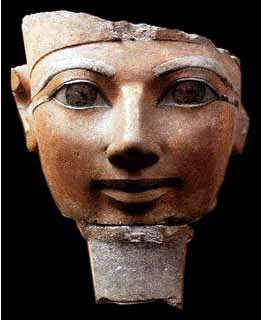 The delicate corpus delicti is a plain flacon from among the possessions of Pharaoh Hatshepsut, who lived around 1450 BCE, currently on exhibit in the Egyptian Museum of the University of Bonn. Beautiful in its simplicity, one might think it to have held Hatshepsut’s perfume used, perhaps, for religious rites.
The delicate corpus delicti is a plain flacon from among the possessions of Pharaoh Hatshepsut, who lived around 1450 BCE, currently on exhibit in the Egyptian Museum of the University of Bonn. Beautiful in its simplicity, one might think it to have held Hatshepsut’s perfume used, perhaps, for religious rites.
.
di Lori Henshey da Examiner.com del 1 settembre 2011 
.
Perfumes were used in ancient religious ceremonies, when early civilizations offered scented flowers, herbs and resins in worship of their gods. Religious rituals often included specific smelling substances. As acting Pharaoh, did Hatshepsut unknowingly poison herself while performing her duties as ancient Egypt’s living god? Apparently, not; for innocuously hidden within this small vessel was a deadly, ancient compound awaiting discovery by modern scientists.
After two years of research, Michael Höveler-Müller and Dr. Helmut Wiedenfeld from Bonn’ Pharmacology Institute discovered the flacon did not hold a perfume; instead, it was a kind of skin care lotion or even medication for a monarch suffering from eczema. In addition, the pharmacologists found a strongly carcinogenic substance. Was Hatshepsut killed by her medicine?
“There is a lot that speaks for this hypothesis,” Dr. Wiedenfeld said. “If you imagine that the Queen had a chronic skin disease and that she found short-term improvement from the salve, she may have exposed herself to a great risk over the years.”
“We have known for a long time that Hatshepsut had cancer and maybe even died from it,” said Michael Höveler-Müller. “We may now know the actual cause.”
At this point, the Bonn scientists can only surmise how Hatshepsut obtained her lotion. “Egyptian physicians were general practitioners and good surgeons, but they were lousy internists,” explained Dr. Wiedenfeld. “It is quite possible that they owe their knowledge of certain medications to their contacts with Persia and India where the healing arts were very advanced even in Antiquity.”
To read the entire study, please click here.
Source: University of Bonn and Science Daily
________________________________
Inserito su www.storiainrete.com il 25 settembre 2011





I have learn a few excellent stuff here. Definitely price
bookmarking for revisiting. I wonder how much effort you put to make this sort of
excellent informative website.
Thanks for your personal marvelous posting!
I definitely enjoyed reading it, you are a great author. I will ensure that I
bookmark your blog and definitely will come back in the foreseeable future.
I want to encourage you continue your great writing,
have a nice day!